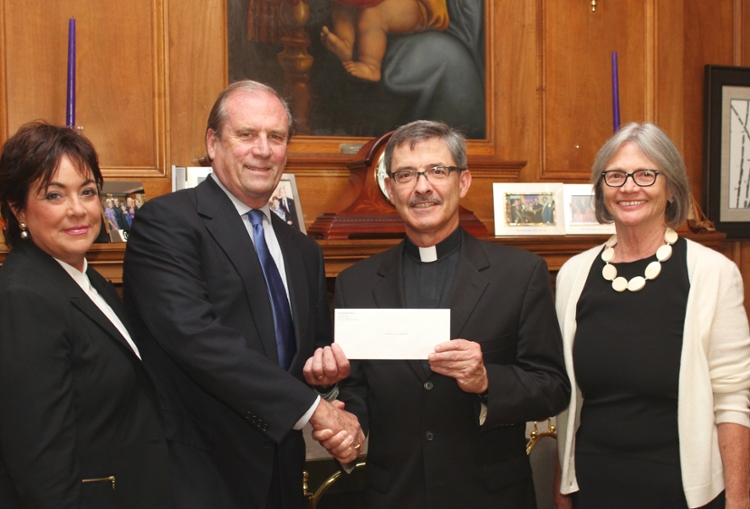University Receives $1.4 Million Gift from Estate of William and Mary Scranton

In December 1941, Worthington Scranton donated his historic and stately home to Bishop William J. Hafey for use by The University of Scranton. “The Stone House,” also known as The Estate, still stands at the center of campus and is a physical testament to the longstanding relationship between the University and several generations of the Scranton family.
That relationship once again manifested itself in a monumental way when, 75 years later, the University received a $1.4 million gift from the estate of Worthington Scranton’s son, Gov. William W. Scranton, who died on July 28, 2013, and his wife, Mary L. Chamberlin Scranton, who died on Dec. 26, 2015.
University President the Rev. Kevin P. Quinn, S.J., called the gift, made in honor of the University’s 22nd president, the Rev. J.A. Panuska, S.J., a milestone and one of the largest gifts in University history.
Two of Gov. and Mrs. Scranton’s children, William W. Scranton III and Susan Scranton Dawson, along with William III’s wife, Maryla, joined Father Quinn at Scranton Hall to mark what Father Quinn called “an important moment in our history.” He also noted Scranton Hall was a fitting place to recognize the continuing support from the city’s founding family.
Scranton Hall was a carriage house until Worthington Scranton added a floor and turned it into an office building in 1928-29. The University acquired the building in 1958, and Panuska renamed it Scranton Hall in 1984 in honor of the Scranton family’s contributions to the University and the city.
In recognizing the $1.4 million gift, Father Quinn said, “At The University of Scranton, we frequently speak of a transformational student experience.” He noted that the gift will significantly contribute to this experience in the Panuska School of Professional Studies, the Kania School of Management, the College of Arts and Sciences and the Weinberg Memorial Library.
The gift also recognizes the service of two longtime University professors by establishing endowments. An endowment in honor of Frank A. Cimini, Ph.D., a 1939 University graduate who began teaching at the University in 1942 and served for many years as a professor of foreign languages, will support the Weinberg Library’s foreign-language collection, and an endowment in honor of history professor Josephine Dunn, Ph.D., will support arts and music education.
In 1997, Gov. Scranton and his wife also designated $100,000 for a similar endowment in Cimini’s name.
The University has awarded honorary degrees to several members of the Scranton family. In 1953, Worthington Scranton received the first honorary degree in the family, followed by his wife, Marion Margery Scranton, who received an honorary degree in 1957. Gov. William Scranton received an honorary degree in 1963, and his wife, Mary L. Scranton, received an honorary doctor of law degree in 1977, seven years after she became the University’s first female trustee. In 1999, William W. Scranton III received his honorary degree and served as commencement speaker for the graduate school.
More recently, the University recognized the contributions of the Scranton family by nominating Mary L. Scranton for the Northeastern Pennsylvania Chapter of the Association of Fundraising Professionals’ Lifetime Achievement Award, the chapter’s most prestigious honor. On Nov. 18, the former first lady of Pennsylvania received that award posthumously during a local celebration of National Philanthropy Day at the Radisson Lackawanna Station.
In his recognition remarks, Father Quinn mingled the past and present, saying “No one gesture has been more transformational than the gift of the Scranton Estate, as the Scranton family gave us their home so that it might become our home.”
That World War II-era gift of a University landmark, which Father Quinn said was vital to the Diocese of Scranton’s efforts to recruit the Jesuits to assume the leadership of the University in 1942, launched a special relationship that has only grown in breadth and depth.
“At the University, we have been blessed by our connection with the Scranton family,” Father Quinn said.
Governor Scranton and his Daughter Become Classmates at the University
Gov. Scranton and his daughter were students of The University of Scranton at one point. After the governor’s death in 2013, Susan Scranton Dawson recalled for the Times-Tribune newspapers a special memory of taking a University class with her father in 1988, after he resigned from all of his extensive business and government affiliations. The class centered on Leonardo da Vinci.
“We were assigned a 20-page paper, and he turned in 120-page paper,” Dawson told the newspaper. “He also had read the entire textbook before the class started.”
Dawson also has made her own special mark on the University in the form of art exhibited across campus. Her words are on display in the Patrick and Margaret DeNaples Center and the Loyola Science Center. As part of the University’s celebration of 125 years, Dawson also created an interactive exhibit called “TAG: Works by Susan Scranton Dawson and You,” in which members of the campus community and visitors were invited to write or draw with marker on the Plexiglas coverings of her abstract works.






